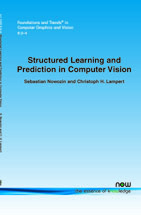Structured Learning and Prediction in Computer Vision
By Sebastian Nowozin, Microsoft Research Cambridge, United Kingdom, Sebastian.Nowozin@microsoft.com | Christoph H. Lampert, IST Austria, Institute of Science and Technology Austria, Austria, chl@ist.ac.at
Abstract
Powerful statistical models that can be learned efficiently from large amounts of data are currently revolutionizing computer vision. These models possess a rich internal structure reflecting task-specific relations and constraints. This monograph introduces the reader to the most popular classes of structured models in computer vision. Our focus is discrete undirected graphical models which we cover in detail together with a description of algorithms for both probabilistic inference and maximum a posteriori inference. We discuss separately recently successful techniques for prediction in general structured models. In the second part of this monograph we describe methods for parameter learning where we distinguish the classic maximum likelihood based methods from the more recent prediction-based parameter learning methods. We highlight developments to enhance current models and discuss kernelized models and latent variable models. To make the monograph more practical and to provide links to further study we provide examples of successful application of many methods in the computer vision literature.
Structured Learning and Prediction in Computer Vision
Powerful statistical models that can be learned efficiently from large amounts of data are currently revolutionizing computer vision. These models possess a rich internal structure reflecting task-specific relations and constraints.
Structured Learning and Prediction in Computer Vision introduces the reader to the most popular classes of structured models in computer vision. The focus is on discrete undirected graphical models which are covered in detail together with a description of algorithms for both probabilistic inference and maximum a posteriori inference. It also discusses separately recently successful techniques for prediction in general structured models. The second part of Structured Learning and Prediction in Computer Vision describes methods for parameter learning, distinguishing the classic maximum likelihood based methods from the more recent prediction-based parameter learning methods. It highlights developments to enhance current models and discusses kernelized models and latent variable models. Throughout Structured Learning and Prediction in Computer Vision the main text is interleaved with successful computer vision applications of the explained techniques. For convenience the reader can find a summary of the notation used at the end of the book.
